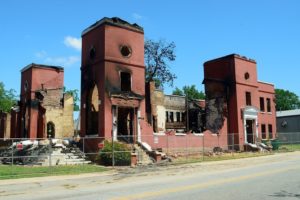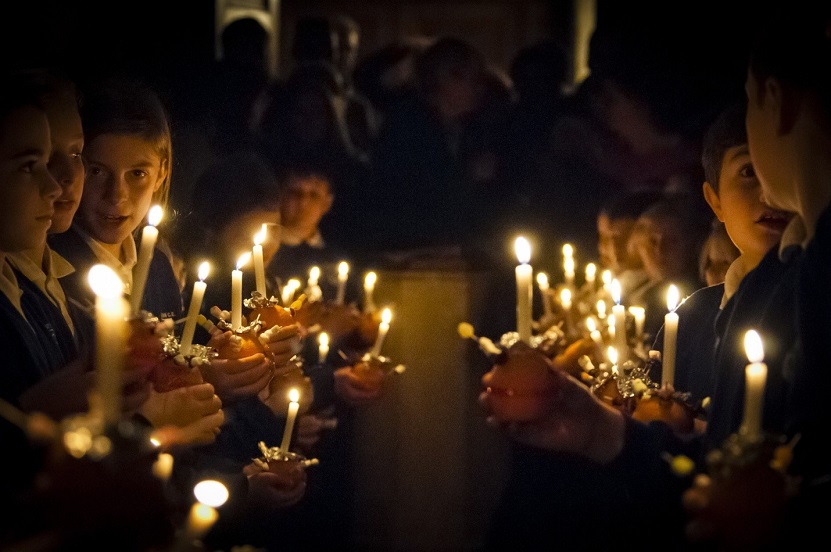“It is better to light a candle than curse the darkness.” Eleanor Roosevelt
Every year, late in December, we are greeted with the news of a church that burned down because of a candle left burning during a Christmas service. It’s not common, but it would sure be embarrassing to be a safety professional and have your church be the one that made the news.
Improbable but not impossible
There are over 1600 religious property fires in the United States every year. The majority are started by cooking equipment, heating equipment, or other electrical equipment. Candles only start about 4% of all religious property fires. However, that is still about 70 religious property fires each year with candles as the ignition source. The winter holiday season is the time when candles are used the most.
The hazard is compounded by the increased number of visitors and guests at religious services during the winter holiday season. The number of people in a service is much more than typical, so temporary seating may be set up, blocking means of egress that are normally quite accessible. Worse, visitors and guest typically don’t know where all the exits are, so are more likely to become disoriented in an emergency.
Personally, I like being joined by visitors and guests. I like the way the sanctuary looks at the church I attend when the lights are dimmed and the room is illuminated almost exclusively by candlelight. I especially love when the gathered congregation, members and their visiting friends and families, light handheld candles as they sing carols. It is one of my favorite things and I wouldn’t deny it to anyone who wanted it. But I would hate to see anyone hurt or property lost because of it. So I make it a point to work with the stewards of our church to assure that the use of candles is safe.
Meet with the worship leader
When there is going to be a special use of candles, whether as part of the liturgy, such as an Advent wreath, or as decoration, or with handheld candles, there is a heightened opportunity for problems. The worship leader will have great influence in the placement of fixed candles and in caring for the congregation in an emergency.
I meet with our pastor as a reminder of the importance of keeping combustible materials away from candles, including candles that fall over. Combustible materials can include greenery or ribbons that some will want to place around the candles, or straw in a manger. It can also include carpeting or upholstery on a pew.
I also remind our pastor to take a moment before the service begins to announce the exit routes from the sanctuary and to quickly review candle safety prior to those services where candles will be hand held. Fortunately for our congregation, our pastor is already committed to the idea that if there is an emergency, it is not a case of “the show must go on.” In an emergency, the service will stop, the lights will come up, and our pastor will use the pulpit to direct an orderly evacuation.
The time to meet with the worship leader is not during a few stolen moments just before a special service begins. At a time like that, a worship leader will have dozens of concerns about the service. Safety will get a nod, but no thought. The time to meet with the worship leader is well before the special services, perhaps after a service earlier in December. Ask if there are plans in place and offer your services. There are two things you can offer to do that require little effort but can make a world of difference: follow up on fire extinguishers and check on exit routes.
Fire extinguishers
The first thing I do, typically early in December, is check to make sure that the fire extinguishers are current. It should go without saying that fire extinguishers, even fire extinguishers in a house of worship, should be inspected monthly and subject to an annual maintenance check. If they are not up-to-date, getting them up-to-date has to be a priority. Christmas Eve is not a good time. It doesn’t matter that it’s not my responsibility. Saying “I told you so” doesn’t count for much after the harm is already done.
Then I meet with the ushers to review how to use fire extinguishers. Most people have never used a fire extinguisher and during a fire is a terrible time to try to figure it out. When possible, I try to meet with the ushers before the holiday services begin, but there are years when it comes down to meeting with the ushers just prior to each service. In addition to knowing how to use fire extinguishers, I make sure they know where each fire extinguisher in the building is. It is during this meeting that we also discuss and review the action plan for any kind of emergency that occurs during a special holiday service.
Exit routes
The second thing I do, typically the day before or the day of the special holiday service, is check the exit routes. This includes the way to exits, the exits themselves, and the discharge from the exits.
First I check that the routes to the exits are unobstructed. I make sure that props from the children’s program have not been stashed in a hallway, blocking an exit door, and that decorations are not hanging from exit signs, obscuring them.
Then I check to make sure that the exits themselves all work. Some doors go unused for months on end and can become stiff or inoperable. Right or wrong, some get locked. It’s important to make sure the doors work.
Finally, I check the discharge from the exits. I make sure that the properties committee hasn’t parked a wheelbarrow or hose reel against one of the doors, making it impossible to open. Because it’s winter, I also check to make sure that snow or ice don’t make the way impassible.
Candle Safety
When members of the congregation are going to be holding candles, the practice is typically to light a few candles near the front of the sanctuary, then for individuals to light their candle from the flame of a neighbors candle. The correct way to do this is for the person with the lit candle to hold it upright, and for the unlit candle to be tipped to it. This keeps the lit candle from dripping hot wax. At the very least, this avoids the mess of dripped wax. More importantly, it avoids burning someone and causing them to drop their lit candle, igniting a bigger fire.
Once candles are lit, it is important to keep them upright, again to avoid dripping wax. It is also important to keep them away from anything flammable: bulletins, music, scarfs, coats, long hair, etc.
Most importantly, for candles that are not held by people in the pews but are fixed in place: never, never, never leave them to burn unattended. I don’t care how nice they look.

An easy problem to avoid
There are about 350,000 religious congregations in the United States. That means that the probability of a candle setting a religious property on fire in any given year is about 1 in 5000. It may be hard to get very excited about a probability of fire that is that low. Certainly, there are other causes of fire that warrant greater concern. Undoubtedly, there will be ushers that insist that they’ve been doing this for umpteen decades and have never seen a fire started by a candle. They will be right. But improbable does not mean impossible, and the possibility of a candle starting a fire is an easy one to do something about.
I don’t want to be the safety professional whose church burned down because of a candle. The steps to take are easy—no fundraising is required and no resources are diverted from other programs.
Offer to help
If you are a member of a congregation that will be using candles in special holiday services, take these three steps:
- Talk to your worship leader, sooner rather than later. Make sure candles are placed and used safely and that your worship leader is prepared to make an announcement prior to services where candles will be used by congregants and during services if there is an emergency.
- Make sure there are fire extinguishers that are ready to be used and that the ushers are ready to use them.
- Just prior to special holiday services, make sure the exit routes are unobstructed and passible.
Enjoy the holidays!
